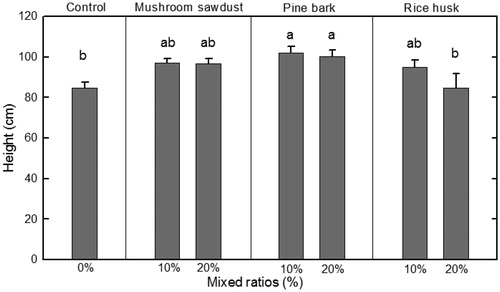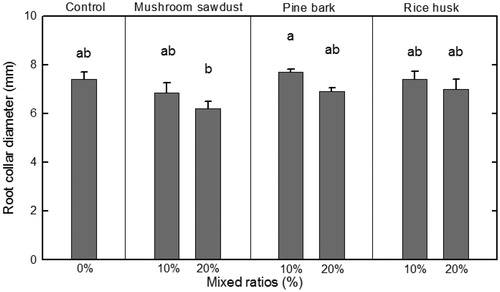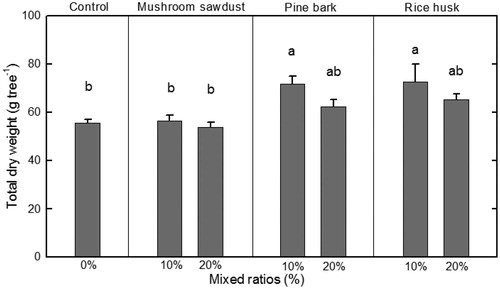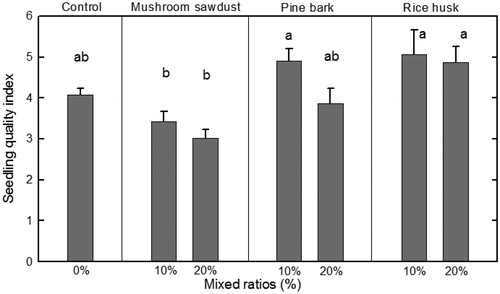Abstract
Quality of produced seedlings relies mainly on the substrate on which it grows and develops. In this study, three common biomaterials – pine bark, carbonized rice husk and mushroom sawdust, were mixed with growing media in two ratios (10% and 20%) to assess their effects on growth and seedling quality of Prunus sargentii seedlings in containerized production system. Generally, 10% pine bark treatment showed the highest results among others in some parameters of seedling growth – height and root collar diameter. For total biomass, 10% rice husk treatment was highest, followed by 10% pine bark treatment. Seedling quality index at 10% rice husk treatment resulted highest (24% increase compared to control) followed by 10% pine bark treatment (20% increase compared to control). Our results suggested that both rice husk and pine bark can be used in 10% mixed ratio to growing media to gain the qualified P. sargentii seedlings in forest nurseries, which in turn, will help to establish successful reforestation in the field.
Introduction
For successful forest restoration in the field, quality seedlings with optimal growth potential are essential. Thus, nurseries need to produce strong and vigorous seedlings that can adapt well to the site they are planted in to ensure successful establishment of the plantations. Seedlings have been produced in mass amount in nurseries by two ways; with containers and with bare root stocks. Production of seedlings by containers has many advantages over bare root stock such as quick production, uniform size, extending planting season, and performing well on adverse sites (Stein et al. Citation1975; Tsakaldimi et al. Citation2005). Moreover, container-grown seedlings generally have smaller shoot-to-root ratios and larger fine roots than bare root seedlings, that can adapt certain transplanting stresses such as drought (Miller Citation1999; Grossnickle and El-Kassaby Citation2016).
“Effective growing medium” is very important in order to achieve the goal of better container-grown seedlings. The growing medium should have a physical structure, which can adjust air and water storage both during and between irrigation to avoid root asphyxia and drought stress (Fonteno Citation1993). For many years, most nurseries in the world depended mainly on peat as their growing media (Ostos et al. Citation2008) to get the best morphological attributes. However, due to its increasing environmental concerns that peat bogs are being rapidly depleted, researches on peat alternative became the great interest among life scientists (Ingelmo et al. Citation1998; Guerrero et al. Citation2002; Chong Citation2005; Wilson et al. Citation2006).
Different organic or inorganic substrates, for examples, composted waste, coconut coir, sawdust, rice hulls, biochar, pine bark, cattle manure, mushroom compost, perlite, and vermiculite, have been used for production of forest seedlings (Mathers et al. Citation2007). Seedling growers, recently, have also been looking for more locally produced growing media to reduce the cost of transportation for them (Ge et al. Citation2012; Heiskanen Citation2013).
One of major components of container media used in nurseries are bark from pine (Pinus taeda) and douglas fir (Pseudotsuga menziesii), which improves water and air movement in container resulting in increasing nutrient uptake (Simmons and Derr Citation2007; Gomóz and Robbins Citation2011). Using rice husk in nurseries is a way of trying a low cost soil amendment because of by-products of agriculture (Lordan et al. Citation2013) to gain benefits for crop performance and soil amelioration. Chandrasekhar et al. (Citation2003) reported that about 0.23 tons of rice husk is formed for every ton of rice produced in the milling industries. It was estimated that a total of 130 million Mg of rice husk is produced in the world every year (Lordan et al. Citation2013). Besides, those huge amounts of rice husks, which were produced worldwide every year, are still treated as bio-wastes, and they are discarded onto rice growing fields, spread on pigpen floors as drying absorbent, or sometimes simply burnt (Sang et al. Citation1997). Spent mushroom substrate may act as organic fertilizer if they are used in mixing with other soil amendments (Davis and Kuhns Citation2005). Levanon and Danai (Citation1995) pointed out that spent mushroom substrate releases nitrogen to the plant in a slow and steady manner, and in gravel and sandy soils, treating like a sponge, creating air spaces for the clay soils, allowing higher potential for drain.
This study determined the most effective biomaterial (pine bark, carbonised rice husk, and mushroom sawdust) and mixed ratio in containarized seedling production system. Current study can recommend which biomaterial and mixed ratio will produce the best seedling quality for containarized production of P. Sargentii in the greenhouse.
Materials and methods
Study sites, species and biomaterials
This study was conducted in the greenhouse managed by the Forest Technology and Management Research Center at Pocheon, South Korea (37°45′N, 127°10′E) from March to November 2017. The greenhouse was fully automated with irrigation, ventilation and environmental control systems. Mean annual temperature for the greenhouse was 13.8 °C and mean humidity was 65.5% in 2017.
Prunus sargentii was used in our study. P. sargentii seeds were germinated in nursery during early March. Three biomaterials (pine bark, carbonized rice husk, and mushroom sawdust) were mixed with growing media before P. sargentii seedlings were planted in the cells. shows the physical and chemical properties of biomaterials used in current study after mixing with artificial soil. pH of all biomaterials in both mixing ratios were acidic and slightly less than that of control, and bulk density showed highest in mushroom sawdust among others. Pine bark was from the Wood Distribution Center in Donghae City, Gangwon Province; mushroom sawdust was from the Forest Mushroom Research Center in Yeoju City, Gyeonggi Province; and carbonized rice husk was purchased from the market. All of these materials were abundantly available in South Korea. The materials were then pulverized using a pulverizer with mesh size of 2 mm in a factory of Chungnam National University, Daejeon, Republic of Korea.
Table 1. Physical and chemical properties of three biomaterials after mixing with growing media.
Experimental design
Trays were used to plant P. sargentii seedlings in our study. Each tray (32 cm × 40 cm) consists of 20 cells, each of them has 6.8 cm in diameter, 15 cm in depth, and a volume of 400 mL. The cells were filled with a mixture of peat moss, perlite, and vermiculite in a ratio of 1:1:1 (v/v/v), which was recommended by Landis et al. (Citation1990) for growth of tree seedlings in a containerized seedling production system.
The 3 × 3 combined experimental design was applied to test the effects of three different biomaterials with two mixed ratios on growth and quality of P. sargentii seedlings. This experiment included 6 treatments for three biomaterials (pine bark, mushroom culture medium and rice husk) with two mixed ratios (10% and 20% respectively), and a control. Control consisted of 400 mL growing media without any biomaterial added. To get 10% mixed ratio, 40 mL of three biomaterials was mixed with 360 mL of growing media, and for the 20% mixed ratio, 80 mL of three biomaterials was incorporated with 320 mL of growing media.
After growing media was mixed with biomaterials, P. sargentii seedlings were transplanted into the cells in late March 2017. Each treatment was replicated five times in a combined experimental design. The trays were then placed on platform in greenhouse that was elevated 60 cm above the floor.
Growth measurements
The innermost 6 seedlings were chosen from each tray as samples to avoid unintentional management errors, such as unequal irrigation and edge effect. The sample seedlings’ height and root collar diameter were measured two times during this study; in August and October 2017. Seedling height was measured from ground to apical meristem, while root collar diameter was measured 1 cm above the ground. Height was measured in cm and root collar diameter in 0.01 mm (Thompson and Schultz Citation1995). Three sample seedlings per tray were harvested in October and divided into stem, leaf, and root. The roots were washed with tap water to remove all soil particles. All components were oven-dried to constant weight at 65 °C for 48 h. Dry weights of stem, leaf and root were measured. Method suggested by Sestak et al. (Citation1971) was used to calculate total mass production and ratio of aboveground to belowground biomass.
Dickson’s quality index (DQI)
To observe the quality of seedlings, Dickson’s quality index was calculated as follows: Quality index = SD/(HD + SR), where SD is seedling’s total dry weight (g), HD is the ratio of seedlings height (cm) to root collar diameter (mm), and SR is the ratio of shoot weight (g) to root dry weight (g) (Deans et al. Citation1989; Cho et al. Citation2017).
Statistical analysis
SAS 9.3 software was used for statistical analyses. Two-way analysis of variance (ANOVA) with Duncan’s multiple comparison tests was applied to analyze the effects of three biomaterials with two mixed ratios on seedling height, root collar diameter, total dry weight, and quality index. All probabilities were tested at a significance level of 0.05.
Results
Height growth
The seedling height of P. sargentii was significantly influenced by treatment; the highest height being observed at 10% pine bark mixed ratio (20% higher in 10% pine bark treatment compared to control), however seedling height did not show difference among other treatments.
Root collar diameter
Root collar diameter followed the same trend with seedling height with highest P. sargentii diameter observed in treatment applied with 10% pine bark. The lowest root collar diameter was in 20% mushroom sawdust.
Leaf, stem, root dry weight and biomass allocation
Both rice husk treatments (10% and 20%) and 10% pine bark had higher proportion in the root biomass (29.3, 27.1, and 29.1 g/tree, respectively) than leaf and stem biomass indicating that root system developed well in these treatments ().
Table 2. Leaf, stem, root dry weight and biomass allocation of Prunus sargentii applied with 3 biomaterials and 2 mixed ratios in a containerized seedling production system.
The amount of total biomass (leaf, stem, and root) showed highest in 10% rice husk treatment followed by 10% pine bark with 72.7 and 71.7 g/tree, respectively. Total biomass was again observed to be lowest in 20% mushroom sawdust treatment.
Seedling quality index (SQI)
Quality index, one of the most useful indexes in determining seedling performance in the field, was significantly higher in both 10% rice husk and 10% pine bark treatments compared to other treatments. Compared to control, quality index of seedlings was 24% higher in 10% rice husk treatment, and 20% higher in 10% pine bark treatment.
Discussion
Treatments of biomaterials and mixed ratio are significant for most measured parameters on P. sargentii seedlings (). Even though above ground parts of P. sargentii resulted highest in 10% pine bark treatment, well-developed root systems showed highest in 10% rice husk treatment, leading to highest total biomass in that treatment. Our findings are in agreement with Faria et al. (Citation2001), who reported that carbonized rice husks can be used as a sole or partial substrate for plant cultivation. Evans and Gachukia (Citation2004) reported the same result in which they used different mixed ratios of parboiled rice hulls to sphagnum peat in tomato plants.
Figure 1. Height growth of Prunus sargentii applied with 3 biomaterials and 2 mixed ratios in a containerized seedling production system. Different letters represent significant differences (p < 0.05) between treatments. Vertical bars represent one standard error of the mean (n = 5).

Figure 2. Root collar diameter growth of Prunus sargentii applied with 3 biomaterials and 2 mixed ratios in a containerized seedling production system. Different letters represent significant differences (p < 0.05) between treatments. Vertical bars represent one standard error of the mean (n = 5).

Figure 3. Total dry weight of Prunus sargentii applied with 3 biomaterials and 2 mixed ratios in a containerized seedling production system. Different letters represent significant differences (p < 0.05) between treatments. Vertical bars represent one standard error of the mean (n = 5).

Figure 4. Seedling quality index of Prunus sargentii applied with 3 biomaterials and 2 mixed ratios in a containerized seedling production system. Different letters represent significant differences (p < 0.05) between treatments. Vertical bars represent one standard error of the mean (n = 5).

Using rice husk in 10% mixed ratio showed the highest root biomass, thus obtaining most of its nutrients and water through well-developed root systems. One of the most important physical properties of substrate is having adequate air-filled pore spaces (Barrett et al. Citation2016). Presence of them can make root and its surroundings to allow drainage and gas exchange, which leads to better root growth. However, it was stated that an increase in bulk density above a certain level can happen to a decrease in root growth, eventually leading to reduction in growth of whole plant (Mathers et al. Citation2007). This finding was in agreement with our study, in which we observed the lowest root biomass and total dry weight in mushroom sawdust applied treatments (Table 3; ).
Total biomass and seedling quality index of P. sargentii seedlings was significantly higher in 10% rice husk treatments than other treatments ( and ). A significant positive relationship existed between root development and quality of the seedlings, because both root biomass and seedling quality index of P. sargentii resulted highest in 10% and 20% rice husk and 10% pine bark treatments. Although height and root collar diameter are commonly used parameters to evaluate seedling quality assessment, Davis and Jacobs (Citation2005) reported that above-ground morphology is not always an accurate predictor for field survival after out-planting. Instead, below-ground parts (root systems) may give a more accurate indication of seedling performance in the field (Davis and Jacobs Citation2005). Bayala et al. (Citation2009) conducted a nursery and field study for seedling quality assessment with five tree species and reported that root collar diameter and Dickson’s Quality Index were the best parameters to estimate the field performance. Compared to their findings, current study can conclude 10% rice husk treatment to be the best for field planting of P. sargentii seedlings.
Conclusion
We conducted a greenhouse study in order to investigate the effects of three biomaterials (pine bark, carbonized rice husk, and mushroom sawdust) and mixed ratio in containerized seedling production system. The biomass results and seedling quality index showed highest in 10% mixed ratio of rice husk, whereas height and root collar diameter resulted highest in 10% mixed ratio of pine bark treatments. All in all, we suggest to use 10% rice husk to mix with growing media in order to succeed the out-planting performance for P. sargentii, because it showed highest results in total biomass and seedling quality index. Moreover, we can also suggest to use 10% pine bark mixed ratio to growing media due to its highest results in height and root collar diameter, and it followed 10% rice husk treatment with little difference in value for total biomass and seedling quality index. Further study for biomaterial application to nursery seedlings should focus on different particle sizes of rice husk, and pine bark other than 2 mm, because physical properties, such as bulk density and total porosity, of these biomaterials can vary depending on the size we use, which can largely affect the growth and quality of seedlings.
Acknowledgments
We would like to thank Asian Forest Cooperation Organization (AFoCO) for supporting Aung Aung to study in Republic of Korea.
Disclosure statement
The authors declare no potential conflict of interest.
Additional information
Funding
References
- Barrett GE, Alexander PD, Robinson JS, Bragg NC. 2016. Achieving environmentally sustainable growing media for soilless plant cultivation systems – a review. Sci Hortic. 212:220–234.
- Bayala J, Dianda M, Wilson J, Ouedraogo SJ, Sanon K. 2009. Predicting field performance of five irrigated tree species using seedling quality assessment in Burkina Faso, West Africa. New Forest. 38(3):309–322.
- Chandrasekhar S, Satyanarayana KG, Pramada PN, Raghavan P, Gupta TN. 2003. Review processing, properties and applications of reactive silica from rice husk – an overview. J Mater Sci. 38(15):3159–3168.
- Cho MS, Meng L, Song JH, Han SH, Bae K, Park BB. 2017. The effects of biochars on the growth of Zelkova serrata seedlings in a containerized seedling production system. Forest Sci Technol. 13(1):25–30.
- Chong C. 2005. Experiences with wastes and composts in nursery substrates. HortTechnology. 15(4):739–747.
- Davis AS, Jacobs DF. 2005. Quantifying root system quality of nursery seedlings and relationship to outplanting performance. New Forest. 30(2–3):295–311.
- Davis DD, Kuhns LJ. 2005. Spent mushroom compost suppresses artillery fungi in landscape mulch. Mush News. 53(10):11–13.
- Deans JD, Mason WL, Cannell MGR, Sharpe AL, Sheppard LJ. 1989. Growing regimes for bare-root stock of sitka spruce, douglas-fir and scots pine. 1. Morphology at the end of the nursery phase. Forestry. 62:53–60.
- Evans MR, Gachukia M. 2004. Fresh parboiled rice hulls serve as an alternative to perlite in greenhouse crop substrates. HortScience. 39(2):232–235.
- Faria RT, Rego LD, Bernardi A, Molinari H. 2001. Performance of differents genotypes of Brazilian orchid cultivation in alternatives substrates. Braz Arch Biol Technol. 44(4):337–342.
- Fonteno WC. 1993. Problems & considerations in determining physical properties of horticultural substrates. Acta Hortic. 342:197–204.
- Ge M, Chen G, Hong J, Huang X, Zhang L, Wang L, Ye L, Wang X. 2012. Screening for formulas of complex substrates for seedling cultivation of tomato and marrow squash. Procedia Environ Sci. 16:606–615.
- Gómez C, Robbins J. 2011. Pine bark substrates amended with parboiled rice hulls: physical properties and growth of container-grown Spirea during long-term nursery production. HortScience. 46(5):784–790.
- Grossnickle SC, El-Kassaby YA. 2016. Bareroot versus container stocktypes: a performance comparison. New Forest. 47(1):1–51.
- Guerrero F, Gascó JM, Hernández-Apaolaza L. 2002. Use of pine bark and sewage sludge compost as components of substrates for Pinus pinea and Cupressus arizonica production. J Plant Nutr. 25(1):129–141.
- Heiskanen J. 2013. Effects of compost additive in sphagnum peat growing medium on Norway spruce container seedlings. New Forest. 44(1):101–118.
- Ingelmo F, Canet R, Ibanez MA, Pomares F, García J. 1998. Use of MSW compost, dried sewage sludge and other wastes as partial substitutes for peat and soil. Bioresour Technol. 63(2):123–129.
- Landis TD, Tinus RW, McDonald SE, Bernett JP. 1990. Containers and growing media. In: The container tree nursery manual. Agricultural Handbook 674. Vol. 2. Washington, DC: USDA Forest Service.
- Levanon D, Danai O. 1995. Chemical, physical and microbiological considerations in recycling spent mushroom substrate. Compost Sci Util. 3(1):72–79.
- Lordan J, Pascual M, Fonseca F, Villar JM, Rufat J. 2013. Use of rice husk to enhance peach tree performance in soils with limiting physical properties. Soil till Res. 129:19–22.
- Mathers HM, Lowe SB, Scagel C, Struve DK, Case LT. 2007. Abiotic factors influencing root growth of woody nursery plants in containers. HortTechnology. 17(2):151–162.
- Miller S. 1999. Successful tree planting techniques for drastically disturbed lands: a case study of the propagation planting of container-grown oak and nut trees in Missouri. In: Vories KC, Throgmorton D, editors. 1999. Proceedings of Enhancement of Reforestation at Surface Coal Mines: Technical Interactive Forum; Mar 23-24. Kentucky: US Department of Interior, Office of Surface Mining, Alton, Illinois and Coal Research Center, University of Southern Illinois, Carbondale, Illinois; p. 157–172.
- Ostos JC, López-Garrido R, Murillo JM, López R. 2008. Substitution of peat for municipal solid waste-and sewage sludge-based composts in nursery growing media: effects on growth and nutrition of the native shrub Pistacia lentiscus L. Bioresour Technol. 99(6):1793–1800.
- Sang EL, Kwang SK, Jae HA, Chang WK. 1997. Comparison of phosphorus removal characteristics between various biological nutrient removal processes. Water Sci Technol. 36(12):61–68.
- Sestak Z, Catský J, Jarvis PG. 1971. Plant photosynthetic production: manual of methods. The Hague, Netherlands: Dr. W. Junk NV.
- Simmons LD, Derr JF. 2007. Pendimethalin movement through pine bark compared to field soil. Weed Technol. 21(04):873–876.
- Stein WI, Edwards JL, Tinus RW. 1975. Outlook for container-grown seedling use in reforestation. J Forest. 73(6):337–341.
- Thompson JR, Schultz RC. 1995. Root system morphology of Quercus rubra L. planting stock and 3-year field performance in Iowa. New Forest. 9(3):225–236.
- Tsakaldimi M, Zagas T, Tsitsoni T, Ganatsas P. 2005. Root morphology, stem growth and field performance of seedlings of two Mediterranean evergreen oak species raised in different container types. Plant Soil. 278(1-2):85–93.
- Wilson SB, Mecca LK, Danielson HE, Graetz DA, Stoffella PJ. 2006. Container and field evaluation of three native shrubs grown in compost-based media. Compost Sci Util. 14(3):178–183.
